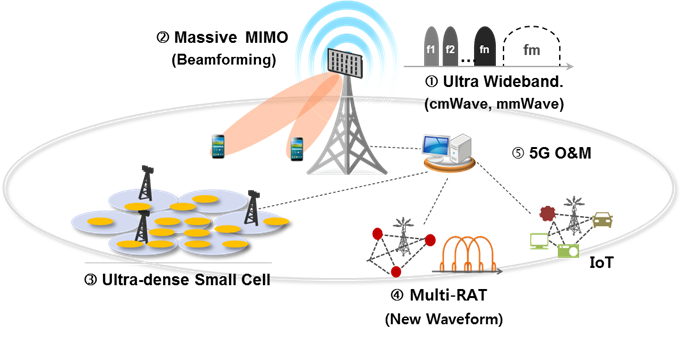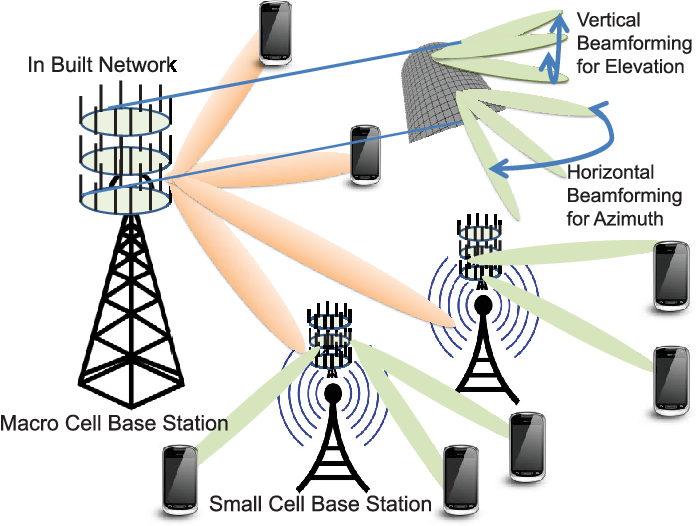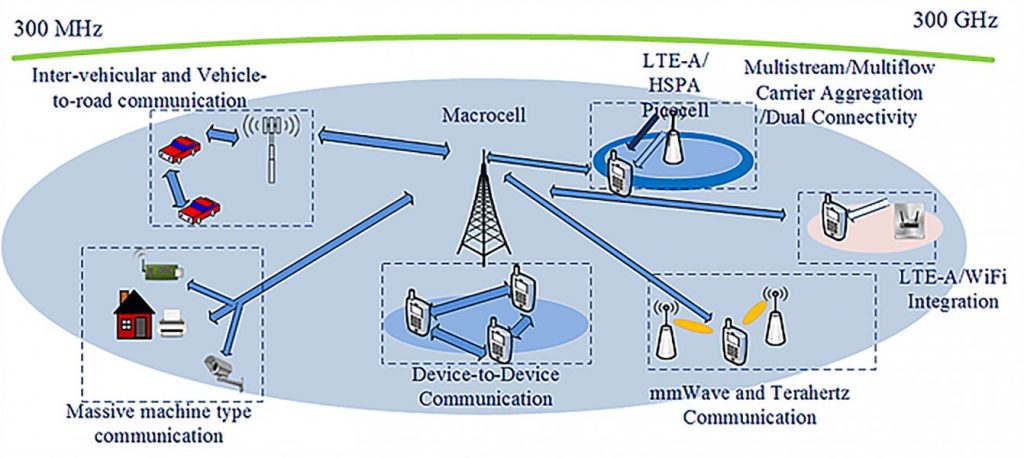The realm of 5G wireless communication systems has been marked by an unwavering focus on the advancement of massive MIMO systems. The use of large antenna arrays at both ends of the spectrum is nothing short of a game-changer, allowing for unprecedented improvements in spectral efficiency and data transmission rates.
Yet still, there exist challenges that loom over this technology like dark clouds. For optimal performance to be achieved in these colossal MIMO systems, groundbreaking research must delve into developing newfangled algorithms and techniques for channel estimation; accurate detection is paramount if we are to ensure reliable communication. Furthermore, advancements in antenna technologies will play a critical role in enabling even more mammoth-scale MIMO systems – only then can we hope to achieve true progress.
Beamforming techniques have also proven themselves effective time and again when it comes to enhancing the performance of massive MIMO systems. By reducing interference between users and increasing signal-to-noise ratio, they serve as potent tools in expanding system capacity and ensuring reliability. It follows then that future research should continue its exploration into different beamforming strategies capable of providing further enhancements.
On the whole, these technological advancements represent a crucial juncture towards building more efficient and resilient wireless communication infrastructures that are equipped to meet society’s demands head-on.

The Role of in Enabling Massive MIMO Systems for Next-Generation Wireless Communication
Contents
- 1 The Role of in Enabling Massive MIMO Systems for Next-Generation Wireless Communication
- 2 Future Research Directions for Large-Scale MIMO Systems and Antenna Technologies
- 3 Beamforming Techniques for Improved Performance of Massive MIMO Systems
- 4 Multi-Cell and Multi-User MIMO Systems for Enhanced Capacity in Wireless Communication
- 5 Precoding and Power Control Algorithms for Efficient Operation of Massive MIMO Networks
- 6 Overcoming Challenges in Channel Estimation for Accurate Detection in Massive MIMO Systems
- 7 Energy-Efficient Massive MIMO Systems for Sustainable and Green Communications.
The perplexing and bursty development of Massive MIMO systems has been a critical juncture in fortifying the spectral efficiency and capacity of wireless communication. The use of an enormous number of antennas in the antenna system is the key factor propelling this technology forward, resulting in heightened spatial multiplexing and amplified signal processing capabilities. Consequently, researchers have devoted their efforts to developing smart antenna technologies that can support multi-cell massive MIMO as well as multiuser MIMO systems.
Recent advances in wireless communications processing have also contributed significantly to the success of Massive MIMO systems. One such technique being explored is beamforming, which directs signals towards specific users or areas within a network for improved performance. This approach was met with great promise at conferences like IEEE Global Communications and IEEE International Conference on Communications.
Another crucial aspect enabling Massive MIMO systems is precoding – optimizing signal transmission based on channel state information (CSI). Precoding algorithms ensure efficient operation by minimizing interference between different users while maximizing overall throughput. Researchers remain committed to discovering novel methods for optimizing precoding in massive antenna arrays for better performance and accuracy without compromising energy efficiency or sustainability goals; particularly relevant given recent interest in vehicular technology applications such as autonomous driving features that require low latency connectivity with high data rates over long distances.

Future Research Directions for Large-Scale MIMO Systems and Antenna Technologies
In the realm of wireless communication, there is a burgeoning fascination with developing enabling technology for 5G. As our world becomes more interwoven and interconnected, it’s clear that faster and more dependable networks are needed to support a wide array of applications. Curiously enough, large-scale MIMO systems and antenna technologies appear to be key players in meeting these increasingly complex demands.
Recent studies have illuminated just how much massive multiple-input multiple-output (MIMO) communication could improve spectral efficiency and capacity in wireless networks. Nevertheless, many challenges still remain before this technology can be implemented on a grand scale. Researchers at the IEEE Global Communications Conference & Workshop on Signal Processing Advances in Wireless have been laboring over signal processing advances for multi-user MIMO systems, performance analysis, power control, precoding in massive MIMO algorithms for massive MIMO, as well as beamforming techniques – all aimed at addressing these issues.
One area where additional research is required pertains to energy-efficient massive MIMO systems designed to foster sustainable and green communications. With concerns about climate change rising ever higher up the global agenda every day that passes by it has become imperative we develop technologies capable of reducing our carbon footprint whilst simultaneously providing high-quality services to users. By focusing intently on energy-efficient design principles such as dynamic power allocation plus optimized antenna configurations researchers hope they will be able to create large-scale MIMOsystems that are both environmentally friendly while also being highly effective…
Beamforming Techniques for Improved Performance of Massive MIMO Systems
The utilization of beamforming techniques has become a widespread practice in the optimization of massive MIMO systems. These methods prove to be exceptionally beneficial for multi-cell and uplink massive MIMO schemes, where interferences from various sources can severely impede system efficiency. By employing beamforming, it becomes possible to direct transmission power towards specific cells or users while minimizing interference with others – ultimately resulting in enhanced spectral efficacy and overall performance.
Moreover, beamforming techniques have proven highly advantageous for multi-user MIMO (MU-MIMO) systems as well. With multiple users sharing the same frequency band concurrently, interference among them poses a significant challenge. However, by spatially separating different users through directed transmissions that minimize interference from other users via beamforming techniques; capacity improvement can be significantly achieved within MU-MIMO scenarios.
Zero-forcing beamforming is another scheme garnering attention due to its simplicity and effectiveness in large-scale antenna systems such as cellular and MIMO-OFDM networks. The idea behind this approach is to nullify interferences amid various antennas by applying an inverse matrix operation on transmit-receive antenna channel matrices. Zero-forcing has demonstrated success in improving signal-to-interference-plus-noise ratio (SINR) metrics while also reducing bit error rate (BER).
In conclusion, implementing efficient massive MIMO systems across diverse applications like multi-cell massive MIMO, multi-user massive MIMO and uplink massive MIMO necessitates the critical role played by beamforming techniques with zero-forcing being an excellent example of its effectiveness over large scale antenna/mimo technologies while energy-efficient approaches hold potential for sustainable green communications through optimized resource allocation strategies within network contexts .\n
Multi-Cell and Multi-User MIMO Systems for Enhanced Capacity in Wireless Communication
The emergence of multi-cell and multi-user MIMO systems has sparked great promise in enhancing the capacity of wireless communication networks. The use of multiple antennas at both transmitter and receiver ends allows for increased spectral efficiency, data rates, and simultaneous user support. However, the utilization of massive MIMO networks with imperfect channel state information (CSI) presents significant challenges such as pilot contamination and interference.
To combat these obstacles, various research studies have proposed beamforming techniques, precoding algorithms, and power control strategies to optimize the performance of multi-cell and multi-user MIMO systems. For instance, utilizing mmWave massive MIMO technology can drastically increase sum rate by capitalizing on directional beamforming capabilities while simultaneously reducing inter-cell interference.
Recent advancements in circuitry and system design have enabled efficient implementation of large-scale antenna arrays for massive MIMO networks. The potentials associated with using massive MIMO in real-world scenarios were discussed extensively at various international workshops such as Asilomar Conference on Signals Systems & Computers or International Workshop on Signal Processing for 5G Wireless Access or Symposium on Wireless Communication Systems & Networks. Despite its potential benefits in enhancing wireless communication capacity while addressing practical limitations; Multi-cell and multi-user MIMO remain an active area of research due to perplexing challenges that arise.
Precoding and Power Control Algorithms for Efficient Operation of Massive MIMO Networks
The challenge of reducing power consumption in massive MIMO systems is one that has perplexed many. Proposed solutions, such as precoding and power control algorithms, have burst onto the scene with promises of optimizing transmission parameters to save energy while maintaining high spectral efficiency.
MIMO beamforming is a particularly intriguing technique used for precoding in these systems. It’s almost like using magic to transmit different signals through multiple antennas at both ends of a mobile radio link, exploiting spatial diversity to its fullest potential. And if that weren’t enough, beamforming can also be used to mitigate intercell interference between users in neighboring cells!
As we look towards future generation wireless communication systems, the excitement around developing more efficient precoding and power control algorithms continues to build. Conferences like ICASSP and WCNC are abuzz with papers on these topics, while journals such as Systems and Computers in Japan or Microwave Technology & Techniques magazine offer comprehensive overviews of recent developments.
In conclusion, it’s clear that precoding and power control algorithms hold the key to unlocking efficient operation of massive MIMO networks. While there may still be some drawbacks associated with these solutions, researchers are bursting with ideas for more sophisticated techniques that promise improved spectral efficiency alongside reduced energy consumption – watch this space!
Overcoming Challenges in Channel Estimation for Accurate Detection in Massive MIMO Systems
The sheer magnitude of antennas involved in massive MIMO systems poses a significant challenge to channel estimation, which only intensifies in mobile radio communications where channels are both time-varying and frequency-selective. However, researchers have proposed various techniques such as pilot-based methods, compressed sensing, and machine learning-based approaches to tackle this conundrum. Recently published at IEEE 77th Vehicular Technology Conference (VTC), an innovative approach based on minimum mean square error (MMSE) was introduced for precise channel estimation in OFDMA systems.
Beamforming has been widely utilized in wireless communications and signal processing to enhance spectral efficiency and energy efficiency by directing signals towards their intended recipients while mitigating interference with other users. Yet beamforming necessitates exact knowledge of the channel state information (CSI), which can be arduous to obtain accurately given the multitude of antennas present in massive MIMO systems. To circumvent this quandary, researchers have proposed various CSI feedback schemes that minimize overhead whilst retaining high accuracy.
Another method for surmounting challenges related to channel estimation lies within relaying systems that use multiple nodes for transmitting signals over greater distances without requiring additional infrastructure or resources. This technique has the potential to amplify coverage and capacity whilst augmenting energy efficiency through reduced transmission power requirements. Furthermore, research suggests that relay-assisted multi-cell and multi-user MIMO systems can offer considerable advantages compared to traditional time division multiple access (TDMA) strategies for multimedia communication applications like video streaming or online gaming.
Energy-Efficient Massive MIMO Systems for Sustainable and Green Communications.
The realm of sustainable and green communications is witnessing a surge in the relevance of energy-efficient massive MIMO systems. These systems are instrumental in curbing energy consumption, while ameliorating spectral efficiency and capacity. However, due to the colossal number of antennas employed in massive MIMO, conventional power-hungry signal processing techniques may not be feasible.
To address this predicament, experts have proposed novel methods that focus on reducing power consumption at each antenna by optimizing the transmission scheme. For instance, beamforming techniques can be leveraged to steer signals towards specific users or areas for reduced interference and increased overall effectiveness. Moreover, precoding and power control algorithms can be deployed to ensure efficient operation of massive MIMO networks.
One major challenge encountered by energy-efficient massive MIMO systems is pilot contamination effect – where pilots from different cells impede one another resulting in erroneous detection and channel estimation. To surmount this hurdle, numerous detection and channel estimation algorithms have been devised with an aim to mitigate the impact of pilot contamination. This has paved way for various international symposiums such as International Symposium on Personal Indoor and Mobile Radio Communications (PIMRC), Workshop on Smart Antennas (WSA), International Symposium on Wireless Communication Systems (ISWCS) which cater specifically to detection and channel estimation for energy-efficient massive MIMO systems without compromising their performance.


